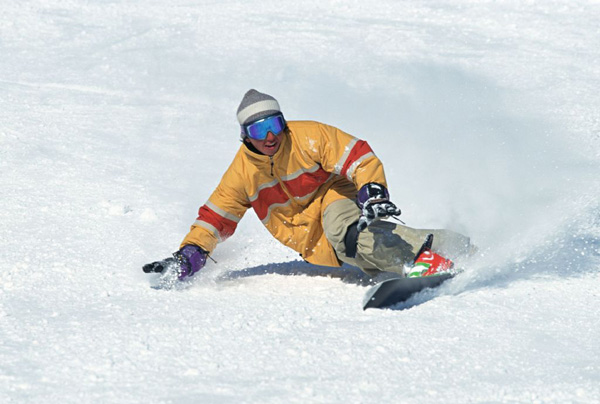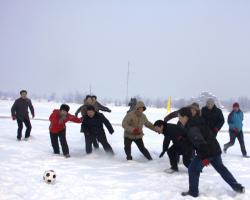Snowboarding in Harbin
Before you start a venture at the slopes of the ski resorts around Harbin, it's very neccessary to select the right gear and know how to use it. Here offers some basic skills, techniques, and maneuvers in Snowboarding, as well as some tips what you should remind of each time you head up the mountain:
Snowboard Basics
Strapping in, standing up and acclimatizing yourself to the board are some of the first few things you need to know as a beginner. In this section, get some valuable Snowboarding Tips on how to gear up on the slope.
Carrying your Snowboard
When you are walking on the slope, watch out for other people or objects that you might hit with your Snowboard. In this section, learn several ways to carry your board.
Skating
Learn Skating so you can move through flat areas or terrains and get on and off the chairlift with ease. Watch our animation and get some Snowboarding Tips.
Switching Edges
This Snowboard Exercise will teach you how to switch edges with both feet strapped in. Just use our animation as your guide as you move from one edge to the other.
Gliding
This basic movement will help you to be comfortable in shifting your weight forward and in gaining Snowboard control. Read our easy-to-follow instructions on how to make straight glides.
Moving Up the Slope
You will have to go up and down the slope repeatedly to learn Snowboarding. In this section, learn how to inch your way up the slope with both feet strapped in.
Snowboarding Tricks
Now that you have already learned Snowboarding with the help of this online course, you may just be able to make advanced moves in your next snowboarding and ski holidays! In the process of Learning How to Snowboard, you can always go back to our online course and get a Snowboarding Tip if you are having difficulties doing a particular maneuver. With the help of these sections, we hope that you will be on your way to becoming a good snowboarder in no time.
Snowboarding Items
Snowboard
In general, an all-mountain snowboard is the best bet for beginners, rather than a specialty board, which is harder to turn and balance on. Also, the longer a board is, the more difficult it will be to control. Choose a board that is the right length for your size and snowboarding ability.
Boots
As the connecting point to your snowboard, boots are a vital piece of equipment. Make sure to get real snowboard boots (not moonboots or hiking boots) that fit correctly to keep your feet comfortable and warm. For most beginner snowboarders, soft snowboard boots are easier to control than hard boots. Always keep your boots laced up tight to give your feet and ankles the support they need.
Bindings
Most snowboard bindings are of the strap-on variety, which are compatible with the greatest number of boots. Be sure to keep your straps securely fastened to give you the most control over your snowboard. Some bindings, though, are step-in types. Make sure you get the right bindings for your boots, and have a trained professional at a snowboard shop adjust the angle of your bindings to put your feet in the right positions.
Helmet
As is the case with many sports, a helmet is the most important piece of equipment when it comes to preventing life-threatening injuries. You should wear one any time you go boarding. Get a helmet that fits properly and keep the chin strap fastened to keep it securely in place. Also, make sure to get a real snowboard helmet (not a football or bike helmet) that allows space for your goggles and ventilation on warm days.
Goggles and sunglasses
The sun's rays are considerably stronger at high altitudes than they are at sea level, and when they bounce off the gleaming white snow, they can be a serious threat to your eyes. Sunglasses are the best way to protect your eyes from the sun's rays, but you should also always bring a pair of goggles that are the right size in case it gets cold or begins to snow. Goggles are also better at protecting your eyes from tree branches and other hazards.
Gloves or mittens
Many snowboard gloves include pockets for hand warmers to keep your fingers nice and toasty. If you're still worried about your hands getting cold, however, it's a good idea to wear mittens, which are generally warmer than gloves.
Wrist guards
When you first learn how to snowboard, you will spend a lot of time falling forward and breaking your fall with your hands. This can lead to broken wrists and forearms, which are very common snowboarding injuries. Be sure to wear rigid wrist guards designed for snowboarding or in-line skating to protect yourself when you fall.
Snowboarding Dress
Here's a rundown on what sort of clothes you should wear when you snowboard to avoid hypothermia and frostbite:
Thermal underwear
As with all snowboard clothing, long underwear should be made of wool or a synthetic fabric such as polypropylene rather than cotton, which will stay wet and cold if it gets wet. The best long johns will fit snugly against your skin to form a warm base layer that your outer layers can fit over easily.
Thermal socks
Thicker is not necessarily better when it comes to socks. A sock that is too thick will make your boots too tight, which will make your feet uncomfortable and cold. Choose socks that are the right thickness for your boots and reach up your leg to just below your knees.
Intermediate layers
Fleeces made from wool or synthetic fabrics work best. Try to find ones that aren't too bulky to fit under your jacket.
Snowboard pants
These should be the right size while allowing your legs to move freely. It can also be helpful, especially when you're learning to snowboard and falling on your rear end a lot, to get pants with a little extra padding in the seat. Be sure to get a pair of pants that are waterproof or water-resistant.
Jacket
The best jackets will have plenty of pockets to store your gear. Many people like to use down jackets, which tend to be the warmest kind, but thin shells with extra intermediate layers can work just as well. As with snowboard pants, all snowboard jackets should be waterproof or water-resistant.
Neck gaiter
On really cold days, you'll want to have a gaiter that covers your neck and can be pulled up to cover your face. The best ones will also have a hood to go under your helmet. Remember, you lose a lot of heat through the top of your head, so keeping your head warm is the first step to keeping the rest of your body warm.















